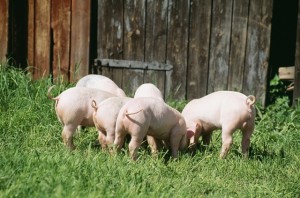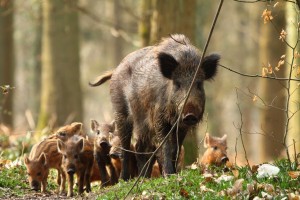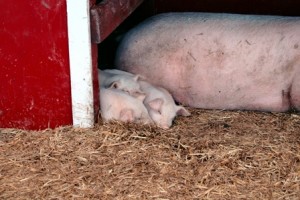Piglet behaviour

Outdoor reared piglets are also heavier at the same weaning age as their indoor-reared counterparts (Miller et al., 2007)
Some of the behavioural problems associated with weaning piglets, including belly nosing, ear and tail biting and low intake of solid food are less pronounced in piglets reared on outdoor systems and in part this is a consequence of them learning specific foraging and social skills and they have been observed to show a richer behavioural repertoire (Cox and Cooper, 2001; Hötzel et al., 2004). Behavioural problems in pigs reared outdoors are less pronounced than in confined pigs.
When to wean?
Naturally, a sow would not begin to wean her piglets until they were at least 12 weeks of age, and they would be gradually weaned at around 14 to 17 weeks of age (Jensen, 1986). In commercial pig production systems, piglets are frequently removed from their mothers when they are less than 4 weeks of age, although in some welfare friendly systems, such as organic farming, they are frequently left with their mothers until they are 8 weeks. Early weaning has negative impacts on social behaviour, stress, and weight gain, and even though the effects are more pronounced when pigs are weaned very young, the effects are still observed at 28 day weaning (Colson et al., 2006).
Jensen and Recén (1989) regard suckling as a special case of foraging, with the young deciding to stop suckling as they reach a stage of optimal foraging.Throughout natural rearing, suckling frequency decreases uniformly through lactation, and after 10 weeks the number of sucklings initiated by the mother decreases. The mother tends to terminate all sucklings after 4 weeks, and the mother gradually and uniformly increases the number of sucklings where she stands until she stands for all suckling sessions. Naturally, weaning occurs later during winter i.e in autumn born litters, and the weaning age increases with number of births (parity) (Jensen and Recén, 1989).
Maternal Behaviour

The maternal behaviour of sows at birth is similar to that of wild boars and feral pigs (http://circleranchtx.com/)
The onset of nest building behaviours, such as pawing and gathering straw, is associated with hormonal changes just prior to birth (Algers and Uvnäs-Moberg, 2007). When sows are allowed to exhibit natural behaviour at farrowing, they will leave the rest of the herd 24 hours before giving birth, and spend time examining potential nesting sites, which may involve continuous wandering lasting 4–6 hours and moving between considerable distances. The nests they build are similar to those a European wild boar may build, and after farrowing, they will remain with or close to the litter for about 9 days. After this, the nest is abandoned and the piglets follow the mother and re-join the rest of the herd although they remain an intact social unit throughout lactation. Naturally, the piglets are weaned at between 14 and 17 weeks (Jensen, 1986).
See Pig Housing for more on nesting facilities and family groups.
Piglet mortality
Piglet mortality in outdoor herds can be high and seasonally dependent (higher in late autumn-early winter). In the UK, pre-weaning mortality is approx. 13-14%, which is slightly higher than that found in indoor systems (O’Reilly et al., 2006; KilBride et al., 2012). It is difficult to attribute the mortality of live born piglets to one single cause, although crushing by the mother has been observed as the most common cause of death (Edwards, 1996) and predation and hypothermia also present high risks. Poor quality pasture can have a negative impact on losses, and this is potentially due to mud being carried to the nesting area by the sow which results in increased humidity and bacterial pollution. The quality of the nest and in particular the amount of straw available in farrowing huts can have a positive impact on mortality (Berger et al., 1997). The percentage of grass and straw may be correlated, in that in the absence of pasture, a sow may consume the straw designed for bedding.
Interference by the stockperson may result in increased piglet death at birth, and particularly if the stockperson is inexperienced. Outdoor sows may be best left alone to farrow (Berger et al., 1997) although others have shown that drying a piglet or moving it to the teat, has also been reported to reduce pre-weaning piglet mortality, albeit in indoor farrowing herds (Anderson et al., 2008).
Insulated farrowing huts reduce fluctuations in internal hut temperature by keeping the interior of huts warmer in winter and cooler in summer compared with non-insulated huts (Randolph et al., 2005) which can reduce mortality risk (KilBride et al., 2014) although not always (Johnson and McGlone, 2003) as the amount of bedding present is also likely to be important.
Huts bedded with deep straw with sloping sides provide a space for piglets to avoid being crushed as the sow lies down (KilBride et al., 2014). A flap of plastic covering the farrowing hut door can significantly reduce piglet mortality possibly by maintaining a stable temperature inside the hut, by preventing young piglets straying from the hut or by deterring predators (KilBride et al., 2014).
Piglet mortality (%) tends to be greater in larger litters, and this may be because births take longer and piglets may be weaker as a result of competing for food (Van der Lende and de Jager, 1991; Hogberg and Rydhmer, 2000; Koketsu et al., 2006; Wolf et al., 2008). There is some evidence that piglet mortality is lower when the stockperson is female, and this may be related to increased empathy and/or better practice e.g drying of piglets at birth (KilBride et al., 2014). Piglet mortality is likely to be higher if the dam is lame. Lame sows are less agile and are at greater risk of crushing their piglets, and they also be nutritionally compromised resulting in lower milk production (Anil et al., 2009). See Pig Lameness


 American English
American English


Comments are closed.